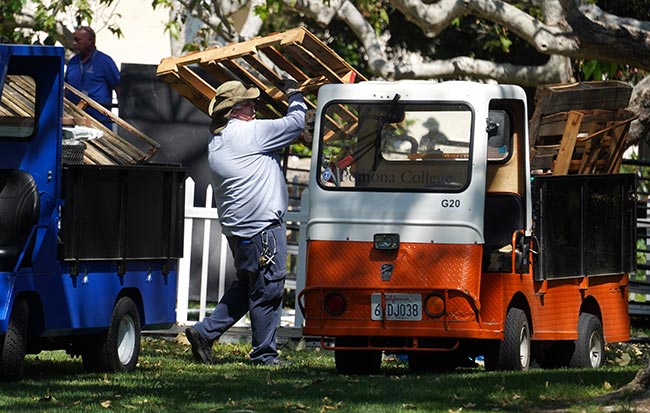City Council sets its 2024-2026 priorities and objectives

Gene Boutilier, president of Housing Claremont, said it was shocking that the City Council left out plans to “pull together the city’s people and resources to complete the state approved housing element and to fully implement that plan and our [regional housing needs allocation] obligations.” Claremont’s RHNA number is 1,711, and refers to the number of new housing units it must build between 2021 and 2029. Courier photo/Andrew Alonzo
by Andrew Alonzo | alonzo@claremont-courier.com
It took three rounds of votes Tuesday but the Claremont City Council unanimously agreed each time to set its priorities and objectives for the 2024-2026 budget cycle, which is July 1, 2024, through June 30, 2026.
The council ratified seven objectives which include: 1) preserving the city’s natural, cultural and historic resources; 2) maintaining financial stability; 3) investing in the maintenance and improvement of local infrastructure; 4) ensuring safety through community-based policing and emergency preparedness; 5) increasing neighborhood livability and expanding business opportunities; 6) promoting community engagement through transparency and communication; and 7) developing anti-racist and anti-discrimination policies as well as a plan to achieve community and organizational diversity, equity and inclusion. Seven similar points were established as the objectives for the city’s priorities two years ago.
During the first vote Tuesday, the council moved to approve six of the seven priorities with a 5-0 tally. They pulled the fifth priority for further discussion and also so that council member Ed Reece could recuse himself since he owns a rental property and could potentially benefit financially.
The issue at hand for the council was the omission of a rental stabilization feasibility study as a subtask. One of the fifth objective’s goals was that the council would look into resources to help people who experience housing instability or displacement, including the feasibility of establishing a Claremont Rental Registry.
Claremont resident Lydia Hernandez, a rent stabilization advocate, expressed disappointment during public comment that the council had omitted language to consider establishing a rent stabilization ordinance.
“You’ve heard repeated requests, pleas, even demands for rent stabilization measures here in Claremont from Claremont residents over nearly two years now,” said Hernandez. “It’s not being said out loud, but through this giant omission, the message that’s resonating is this council refuses to even consider rent stabilization.”
During a staff presentation, Katie Wand, assistant to the city manager, explained that for the city to craft a solid rent stabilization ordinance, acquiring data regarding rent caps and other factors in the city would be a priority, which is why staff were tasked with establishing a rental registry. Rental registries generally act as online service portals where property owners can register rental properties, update unit information, and pay registration fees. The registries also indicate unit supply and whether units are in compliance with state housing laws.
Council member Jed Leano echoed Hernandez’s sentiments as he told his constituents the public is going to keep bringing a rent stabilization ordinance to their attention until something is done, either through action by the city or on the public’s end via a ballot measure vote. Council member Leano said he hopes such an ordinance can be crafted by the council.
“I think the request that has been repeated often is to entertain our own stabilization ordinance and entertain the feasibility of a housing department. Perhaps those two things need to be added together only for the benefit of the discussion of ‘is this even feasible’ and ‘at what cost?’ And the benefit of just entertaining and potentially negotiating a stabilization act,” he said.
Though supportive of local control, an idea that local government take action on local issues, Mayor Pro Tem Corey Calaycay commented that the rent stabilization issue is a complicated one, drawing comparisons between it and the overregulation of insurance.
“As much as I support local control, to me, I don’t see a very clean way of doing this without harming someone. Again, this is not as simple as just willy-nilly saying ‘we’re just going to cap all the rents and let the landlords deal with it,’ it’s more complicated than that,” Calaycay said.
After discussion, the council voted 4-0 with Reece’s recusal, to amend the first bullet point of the first subtask of priority five to include rent stabilization. The altered bullet point will be revised to read: “Continue to explore and promote resources for people experiencing housing stability and/or displacement, including: The feasibility of implementing a Claremont Rental Registry ‘and Rent Stabilization.’”
Council member Leano told the Courier that a rental stabilization ordinance was initially left off the objectives list as it was a compromise made following a priorities meeting a few months ago.
“What you saw on the drafted list was the result of those concessions and agreements from a few months ago,” said Leano. “I’m glad that we reconsidered that because frankly there are ripe examples of cities not being responsive to that request from residents. I think we went the right way in making this a priority but not a settled decision.”
After the amendment vote, Reece came back to the chamber and City Attorney Alisha Patterson instructed the council to ratify the rest of priority five’s subtasks, which they did with a 5-0 vote.
Each of the seven priorities came with a list of tasks the city council plans to pursue over the next two years. Asked if these seven priorities are achievable in a two-year span, council member Leano reinforced that he believed they are. A draft of the proposed 2024 to 2026 council priorities is available at ci.claremont.ca.us.











0 Comments